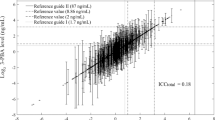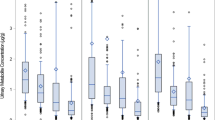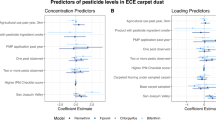Abstract
Background
There is growing concern about children’s chronic low-level pesticide exposure and its impact on health. Green building practices (e.g., reducing leakage of the thermal and pressure barrier that surrounds the structure, integrated pest management, improved ventilation) have the potential to reduce pesticide exposure. However, the potential impact of living in green housing on children’s pesticide exposure is unknown.
Objective
To address this question, a longitudinal study of pyrethroid metabolites (3-phenoxybenzoic acid [3-PBA], 4-fluoro-3-phenoxybenzoic acid [4-F-3-PBA], trans-3-(2,2-dichlorovinyl)-2,2-dimethylcyclopropane carboxylic acid [trans-DCCA]) in first morning void urine, collected from 68 children from New Orleans, Louisiana residing in green and non-green housing was conducted.
Methods
Children were followed for 1 year with three repeated measures of pesticide exposure. Generalized estimating equations examined associations between housing type (green vs. non-green) and urinary pyrethroid metabolite concentrations adjusting for demographic and household factors over the year.
Results
Ninety-five percent of samples had detectable concentrations of 3-PBA (limit of detection [LOD]: 0.1 μg/L); 8% of 4-F-3-PBA (LOD: 0.1 μg/L), and 12% of trans-DCCA (LOD: 0.6 μg/L). In adjusted models, green housing was not associated with statistically significant differences in children’s 3-PBA urinary concentrations compared to non-green housing.
This is a preview of subscription content, access via your institution
Access options
Subscribe to this journal
Receive 6 print issues and online access
$259.00 per year
only $43.17 per issue
Buy this article
- Purchase on Springer Link
- Instant access to full article PDF
Prices may be subject to local taxes which are calculated during checkout

Similar content being viewed by others
References
Rauh VA, Landrigan PJ, Claudio LJ Housing and health. Annals of the New York Acad of Sci. 2008;1136:276-88.
Kim K, Kabir E, Jahan SA. Exposure to pesticides and the associated human health effects. Sci Total Environ. 2017;575:525–35.
Stout DM,II, Bradham KD, Egeghy PP, Jones PA, Croghan CW, Ashley PA. et al. American healthy homes survey: a national study of residential pesticides measured from floor wipes. Environ Sci Technol. 2009;43:4294–300.
Pimentel D, Culliney TW, Bashore T. Public health risks associated with pesticides and natural toxins in foods, Radcliffe’s IPM World Textbook, University of Minnesota, 2018.
Tulve NS, Ruiz JD, Lichtveld K, Darney SP, Quackenboss JJ. Development of a conceptual framework depicting a childs total (built, natural, social) environment in order to optimize health and well-being. J Environ Health Sci. 2016;2:0–0.
Frumkin H, Bratman GN, Breslow SJ, Cochran B, Kahn Jr PH, Lawler JJ, et al. Nature contact and human health: A research agenda. Environmental health perspectives. 2017;125:075001.
Atwood D, Paisley-Jones C. Pesticides industry sales and usage: 2008–2012 market estimates. US Environmental Protection Agency, Washington, DC. 2017;20460.
Blair A, Ritz B, Wesseling C, Freeman LB. Pesticides and human health. Occup Environ Med. 2015;72:81–2.
Lu C, Adamkiewicz G, Attfield KR, Kapp M, Spengler JD, Tao L. et al. Household pesticide contamination from indoor pest control applications in urban low-income public housing dwellings: a community-based participatory research. Environ Sci Technol. 2013;47:2018–25.
Adamkiewicz G, Zota AR, Fabian MP, Chahine T, Julien R, Spengler JD, et al. Moving environmental justice indoors: understanding structural influences on residential exposure patterns in low-income communities. Am J Public Health. 2011;101:238–45.
Walters JK, Boswell LE, Green MK, Heumann MA, Karam LE, Morrissey BF, et al. Pyrethrin and pyrethroid illnesses in the Pacific northwest: a five-year review. Public Health Rep. 2009;124:149–59.
EPA Diazinon revised risk assessment and agreement with registrants. Washington DC: US Environmental Protection Agency, Office of Pesticide Programs; 2001.
Mamane A, Raherison C, Tessier J-F, Baldi I, Bouvier GJ. Environmental exposure to pesticides and respiratory health. Eur Respiratory Rev. 2015;24:462–73.
Bennett DH, Ritz B, Tancredi DJ, Hertz-Picciotto I. Temporal variation of residential pesticide use and comparison of two survey platforms: a longitudinal study among households with young children in Northern California. Environ Health. 2013;12:65.
Saillenfait AM, Ndiaye D, Sabate JP. Pyrethroids: exposure and health effects–an update. Int J Hyg Environ Health. 2015;218:281–92.
Starr J, Gemma A, Graham S, Stout DM. A test house study of pesticides and pesticide degradation products following an indoor application. Indoor Air. 2014;24:390–402.
Nakagawa LE, do Nascimento CM, Costa AR, Polatto R, Papini S. Persistence of indoor permethrin and estimation of dermal and non-dietary exposure. Journal of exposure science & environmental epidemiology. 2020;30:547–53.
Shin HM, McKone TE, Tulve NS, Clifton MS, Bennett DH. Indoor residence times of semivolatile organic compounds: model estimation and field evaluation. Environ Sci Technol. 2013;47:859–67.
Damalas CA, Eleftherohorinos IG. Pesticide exposure, safety issues, and risk assessment indicators. Int J Environ Res Public Health. 2011;8:1402–19.
Ferguson A, Penney R, Solo-Gabriele H. A review of the field on children’s exposure to environmental contaminants: a risk assessment approach. Int J Environ Res Public Health. 2017;14:265
Patino EDL, Siegel JAE. Indoor environmental quality in social housing: a literature review. Build Environ. 2018;131:231–41.
Jacobs DE, Breysse J, Dixon SL, Aceti S, Kawecki C, James M, et al. Health and housing outcomes from green renovation of low-income housing in Washington, DC. J Environ Health 2014;76:8–17.
Colton MD, Laurent JGC, MacNaughton P, Kane J, Bennett-Fripp M, Spengler J, et al. Health benefits of green public housing: associations with asthma morbidity and building-related symptoms. Am J Public Health. 2015;105:2482–9.
Dodson RE, Udesky JO, Colton MD, McCauley M, Camann DE, Yau AY, et al. Chemical exposures in recently renovated low-income housing: influence of building materials and occupant activities. Environ Int. 2017;109:114–27.
Cedeño-Laurent JG, Williams A, MacNaughton P, Cao X, Eitland E, Spengler J, et al. Building evidence for health: green buildings, current science, and future challenges. Annu Rev Public Health. 2018;39:291–308.
Kuczmarski RJ CDC growth charts; United States. 2000.
Trenberth KE. What are the seasons? Bull Am Meteorological Soc. 1983;64:1276–82.
Egeghy PP, Cohen Hubal EA, Tulve NS, Melnyk LJ, Morgan MK, Fortmann RC. et al. Review of pesticide urinary biomarker measurements from selected US EPA children’s observational exposure studies. Int J Environ Res Public Health. 2011;8:1727–54.
Davis MD, Wade EL, Restrepo PR, Roman-Esteva W, Bravo R, Kuklenyik P, et al. Semi-automated solid phase extraction method for the mass spectrometric quantification of 12 specific metabolites of organophosphorus pesticides, synthetic pyrethroids, and select herbicides in human urine. J Chromatogr. 2013;929:18–26.
Li AJ, Kannan KJ. Urinary concentrations and profiles of organophosphate and pyrethroid pesticide metabolites and phenoxyacid herbicides in populations in eight countries. Environ Int. 2018;121:1148–54.
Joint Committee for Traceability in Laboratory Medicine, 2019. Joint Committee for Traceability in Laboratory Medicine Database. Available. https://www.jctlm.org/
Caudill SP, Schleicher RL, Pirkle JL. Multi‐rule quality control for the age‐related eye disease study. Stat Med. 2008;27:4094–106.
Barr DB, Landsittel D, Nishioka M, Thomas K, Curwin B, Raymer J, et al. A survey of laboratory and statistical issues related to farmworker exposure studies. Environ health Perspect. 2006;114:961–8.
Rosner B. Fundamentals of biostatistics. Nelson Education; Toronto ON, Canada 2015.
Greenland S, Pearce N. Statistical foundations for model-based adjustments. Annu Rev public health. 2015;36:89–108.
Urinary concentrations of metabolites of pyrethroid insecticides in the general US population: national health and nutrition examination survey 1999–2002. Environ Health Perspect. 2010;118:742.
Fourth national report on human exposure to environmental chemicals: updated tables, January 2019, Volume 1. National Center for Environmental Health; 2019 Jan. https://www.cdc.gov/exposurereport/pdf/FourthReport_UpdatedTables_Volume1_Jan2019-508.pdf.
Lehmler HJ, Simonsen D, Liu B, Bao W Environmental exposure to pyrethroid pesticides in a nationally representative sample of US adults and children: the national health and nutrition examination survey 2007-2012. Environ Pollution. 2020;115489.
Bradman A, Quirós-Alcalá L, Castorina R, Schall RA, Camacho J, Holland NT, et al. Effect of organic diet intervention on pesticide exposures in young children living in low-income urban and agricultural communities. Environ Health Perspect. 2015;123:1086.
Attfield KR, Hughes MD, Spengler JD, Lu C. Within-and between-child variation in repeated urinary pesticide metabolite measurements over a 1-year period. Environ health Perspect. 2014;122:201–6.
Allen JG, MacNaughton P, Laurent JGC, Flanigan SS, Eitland ES, Spengler JD. Green buildings and health. Curr Environ Health Rep. 2015;2:250–8.
Dereumeaux C, Saoudi A, Goria S, Wagner V, De Crouy-Chanel P, Pecheux M, et al. Urinary levels of pyrethroid pesticides and determinants in pregnant French women from the Elfe cohort. Environ Int. 2018;119:89–99.
Fortes C, Mastroeni S, Pilla M, Antonelli G, Lunghini L, Aprea C. The relation between dietary habits and urinary levels of 3-phenoxybenzoic acid, a pyrethroid metabolite. Food Chem Toxicol. 2013;52:91–96.
Morgan MK. Predictors of urinary levels of 2, 4-dichlorophenoxyacetic acid, 3, 5, 6-trichloro-2-pyridinol, 3-phenoxybenzoic acid, and pentachlorophenol in 121 adults in Ohio. Int J Hyg Environ Health. 2015;218:479–88.
Sandel M, Phelan K, Wright R, Hynes HP, Lanphear BP. The effects of housing interventions on child health. Pediatr Ann. 2004;33:474–81.
LaKind JS, Idri F, Naiman DQ, Verner M-A. Biomonitoring and nonpersistent chemicals—understanding and addressing variability and exposure misclassification. Curr Environ Health Rep. 2019;6:16–21.
Tulve NS, Egeghy PP, Fortmann RC, Xue J, Evans J, Whitaker DA. et al. Methodologies for estimating cumulative human exposures to current-use pyrethroid pesticides. J Exposure Sci Environ Epidemiol. 2011;21:317–27.
Lin Y, Kupper L, Rappaport S. Air samples versus biomarkers for epidemiology. Occup Environ Med. 2005;62:750–60.
Caruana EJ, Roman M, Hernández-Sánchez J, Solli P. Longitudinal studies. J Thorac Dis. 2015;7:537
Burns CJ, Pastoor TP. Pyrethroid epidemiology: a quality-based review. Crit Rev Toxicol. 2018;48:297–311.
Koureas M, Tsakalof A, Tsatsakis A, Hadjichristodoulou C. Systematic review of biomonitoring studies to determine the association between exposure to organophosphorus and pyrethroid insecticides and human health outcomes. Toxicol Lett. 2012;210:155–68.
Acknowledgements
The authors would like to thank the children and their parents for their participation and our community partners at Sojourner Truth Neighborhood Center for their assistance throughout the study.
Funding
This study was funded by the Centers for Disease Control and Prevention (CDC) grant #5UO1EH000990 and by the U.S. Environmental Protection Agency (U.S. EPA) interagency agreement #DW-75-95845001.
Author information
Authors and Affiliations
Corresponding author
Ethics declarations
Conflict of interest
The authors declare no competing interests.
Additional information
Publisher’s note Springer Nature remains neutral with regard to jurisdictional claims in published maps and institutional affiliations.
Rights and permissions
About this article
Cite this article
Werthmann, D.W., Rabito, F.A., Stout, D.M. et al. Pyrethroid exposure among children residing in green versus non-green multi-family, low-income housing. J Expo Sci Environ Epidemiol 31, 549–559 (2021). https://doi.org/10.1038/s41370-021-00312-w
Received:
Revised:
Accepted:
Published:
Issue Date:
DOI: https://doi.org/10.1038/s41370-021-00312-w
Keywords
This article is cited by
-
Association between pyrethroid exposure and osteoarthritis: a national population-based cross-sectional study in the US
BMC Public Health (2023)
-
Characterization of multiple pesticide exposure in pregnant women in Brittany, France
Journal of Exposure Science & Environmental Epidemiology (2022)
-
Exploratory analysis of the association between pyrethroid exposure and rheumatoid arthritis among US adults: 2007–2014 data analysis from the National Health and Nutrition Examination Survey (NHANES)
Environmental Science and Pollution Research (2022)



